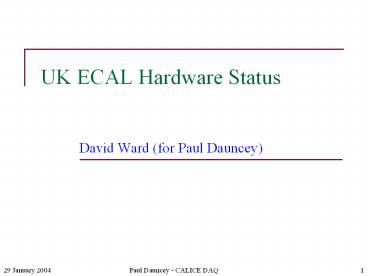UK ECAL Hardware Status
Title: UK ECAL Hardware Status
1
UK ECAL Hardware Status
- David Ward (for Paul Dauncey)
2
People
- Work presented here due to
- Rutherford Laboratory
- Adam Baird, Rob Halsall, Ed Freeman
- Imperial College London
- Osman Zorba, Paul Dauncey
- University College London
- Matt Warren, Martin Postranecky
- Manchester University
- Dave Mercer
3
Readout electronics overview
- CALICE ECAL has 30 layers, 18?18 channels/layer,
9720 total - Each gives analogue signal, 14-bit dynamic range
- Very-front-end (VFE) ASIC (Orsay) multiplexes 18
channels to one output line - VFE-PCB handles up to 12 VFEs (216 channels)
- Cables from VFE-PCBs go directly to UK VME
readout boards, called Calice Ecal Readout Cards
(CERCs)
4
CERC overview
- Eight Front End (FE) FPGAs control all signals to
front end electronics via front panel input
connectors - Back End (BE) FPGA gathers and buffers all event
data from FE and provides interface to VME - Trigger logic in BE for timing and backplane
distribution only active in one board - Each input is one full or two half-full VFE-PCBs
need 45 inputs 6 CERCs
5
CERC features
- Based on CMS silicon tracker readout (FED)
- Will borrow a lot of firmware from them
- Unfortunately not yet as well-developed as hoped
- Dual 16-bit ADCs and 16-bit DAC
- DAC fed back for internal as well as front end
calibration - ADC 500kHz takes 80ms to read and digitise
event data from VFE-PCB - No data reduction in readout board
- ECAL event size 3.5 kBytes per board, 20 kBytes
total per event - On-board buffer memory 8 MBytes
- No buffering available in ECAL front end receive
data for every trigger - Memory allows up to 2k event buffer on readout
board during beam spill - VME readout speed 20 MBytes/s several seconds
readout after spill - Large amount of unused I/O from BE FPGA to
backplane - Will implement trigger logic and control/readout
interface to VME in BE
6
CERC status
- Prototype design completed last summer
- Two prototype boards fabricated last year
- Arrived on November 21 at Rutherford Laboratory
- Currently under stand-alone tests in the UK
- Aim to test with a VFE-PCB in the UK very soon
- Move UK hardware to Paris (Ecole Polytechnique)
for cosmic tests with fully populated VFE-PCB
with Si wafers in Feburary
7
Test setup
- Final path for data has several complex steps
- FE digitises ADC data for each trigger
- Automatically transferred to 8MByte memory
- Memory read from VME when bandwidth available
- Needs data transfer, memory control and VME
interface - BE FPGA firmware not yet functional
- Memory components delayed in delivery not yet
mounted on CERCs - Aiming for end of March for all this to be
working - Backup for VFE tests
- Implement simple RS232 interface from PC to BE
and hence to FEs - FE digitises ADC data and stores in FIFO in FE
- RS232 reads FIFO one word at a time directly to
PC - 8MByte memories bypassed, must read each event
before next trigger - Rate is slow 1Hz for events sufficient for
cosmics
8
Test setup data paths
Common to both
Final VME path not yet functional
RS232 path functional
9
Test results
- RS232 path complete
- Read and write configuration data to RAMs in FEs
- Read and write fake event to RAMs in FEs
- Read back fake event via FIFO on trigger
- Tested for several hours continuous running no
errors seen - Trigger input working
- Can fire trigger from BE with RS232 command
- Can send trigger as LVDS signal on spare
backplane pins to BE - Both functional allows external cosmic trigger
for VFE tests - ADC readout and DAC control still under
development - ADC can be read, DAC can be set
- DAC can be looped back to ADC internally and
through front panel - All control at present only via Xilinx Chipscope
tool - No way to take multiple readings no noise
measurement or DAC calibration - Connection to RS232 I/O path still needs to be
implemented
10
Known CERC problems
- FPGAs do not always load correctly on CERC
power-up - Sometimes need to press reset button several
times - Firmware stored on CompactFlash card replacing
this also works - Thought to be due to power-up boot timing
sequence - Can be adjusted but depends on firmware so wait
until semi-final code ready - Mismatch of DAC output op-amp differential range
and ADC input op-amp differential range - DAC differential output only single polarity
- Can only cover top half of ADC range
- Problem in DAQ op-amp, not ADC, so real signals
should be unaffected - Unclear if DAQ will have problem with VFE-PCB
expected differential range? Wait until we get a
VFE-PCB to find out! - Not yet clear if these can be fixed or require
redesign
11
Future plans
- VFE tests in Paris in February
- Essential test of prototypes before moving to
production - Possible AHCAL test in March
- Need more information on what this entails
number of channels, interface specification to
VFE-PCB equivalent, etc. - Finalise redesign by end March
- Assuming tests successful
- Relayout and fabricated nine production CERCs in
April-May - Simple fix for known problems may be possible
- If so, may not relayout save a month
- Only have components for nine boards need to
know early if more wanted - Also need the money UK has no money for extra
CERCs! - Full ECAL system tests from July onwards
- On schedule for DESY ECAL beam test in Oct/Nov































